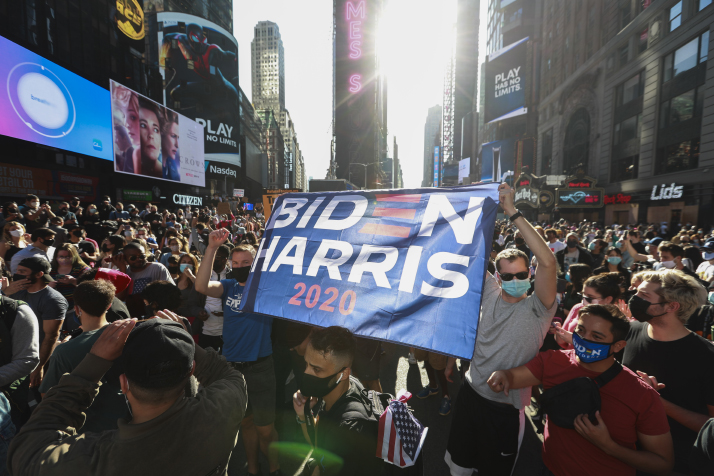As Predicted, Biden Wins, Trump Attacks, the U.S. Risks Greater Crises

One shudders to think where the U.S. will be in five, 15 or 30 years—even if Biden is able to govern effectively for the next four.
The apparent and poll-predicted election of Joe Biden to the U.S. presidency has produced other predictable results. Donald Trump steadfastly refuses to concede and begin processes designed to produce a smooth transition of power by January 20, 2021, when his term ends and the new president will be inaugurated. In fact, there is no law that he cooperates with the transition, and he is well within legal rights to contest results in states where he or his surrogates have alleged fraud.
These efforts are unlikely to overturn Biden’s win not simply because of actual vote totals, but also because a Reuters/Ipsos poll indicates nearly 80 percent of Americans believe Biden won. Nevertheless, Trump will delay certification of the vote in some places, undermine public confidence in the system and outcome, further inflame polarities and tensions nationally, and make it even harder for a new administration to get its footing in a time when the nation is reeling from COVID-19 cases exceeding 100,000 per day on average.

Domestic impacts
Trump’s politics largely present a retrograde revolution hinging on the psychopathology of transference, as is so frequently the case with populists, and which in Trump’s case saw ’80s narcissism become for so many a welcome return to an authentic national ego of “one nation, under God” and above all others.
This reduction of politics to a largely imaginary order was never capable of reconciling with the new structural realities facing Americans at home and abroad. The inability to face these changes honestly not only hamstrung real reforms, but it also left the U.S. vulnerable to an accelerated decline, particularly when it encountered new crises like the pandemic, on top of a multitude of others, none of which could be imagined away with Make America Great Again/Keep America Great slogans.
Trump’s biggest policies were unsustainable and self-defeating. His economic policies constructed a house of cards—debt-fueled fiscal policies, unaffordable tax cuts favoring the rich, massive but largely ineffectual bailouts, and promises to rebuild America’s crumbling infrastructure that remains unfulfilled.
His policies regarding climate change have worsened both domestic and global prospects. His neo-mercantilist trade policies have bludgeoned bilateral deals wherever possible, and where they have failed to win even short-term gains, as in the case of China, have instead blossomed into a self-defeating trade war with immense costs to U.S. workers, consumers and businesses.
And finally, his pandemic policies have helped the virus run nearly unchecked in the U.S., costing billions of dollars and almost a quarter of a million lives, with profound ripple effects across the globe.
But the dream Trump has personified for so many can’t be so easily imagined away either. With his popular support exceeding 65 percent in some states and a national election result that places him at roughly 48.3 percent nationally to Biden’s 51.7 percent, almost half of the nation clings to Trump’s vision despite the worsening national conditions since he took office.
The fantasy Trump represents for so many is zero-sum if not apocalyptic. It remains to be seen if he will do everything within his power to cling to power and destroy Biden’s capacity to govern, but it is quite clear that many of his supporters remain devoutly committed to his assertion that a Biden presidency marks America’s end. Consequently, we should not be surprised if some will choose to fight and create chaos even if doing so is wantonly self-destructive, as for many this is already seen as a national life-or-death struggle.
While it seems unrealistic to expect a true civil war as some call for and others worry over, while real violence is likely to be limited and suppressed quickly when it arises, the cumulative effects of an angry, lame-duck president who might do everything within his power to weaken his successor and to further entrench political polarization and conflict nationally, bode ill for a nation already sick with graver troubles.
Foreign policy
Internationally, those who worry the U.S. might lash out militarily in Trump’s waning days have serious reasons to be concerned. On one hand, a wounded president is still quite powerful in terms of foreign policy, and might resort to stronger actions overseas to compensate for his weakening position at home. And above all, he faces powerful incentives to strike quickly to achieve objectives that were planned for a second term.
On the other hand, while U.S. military capabilities remain first globally, American adversaries are not without their own capabilities. That said, the overall weakening of the U.S. position threatens allies and adversaries alike. Allies see their guarantor in steep decline, but the insecurity this produces affects everyone. It also creates additional burdens as the U.S. not only fails to govern itself effectively and thus undermines global conditions, it also retreats from the global system and pushes burdens it once carried onto others who are ill-prepared to handle them.
In short, the problems facing U.S. competitors are twofold: Be ready for conflict at a moment’s notice, but also prepare for a rapidly changing global environment in which American decline is accelerating in ways that will produce more global chaos—and do so in the midst of a pandemic, climate change, and already significant shifts in geostrategic realities given China’s rise and with Europe, Russia and India struggling to move past the current crisis and those long festering.
Iran in particular has been singled out by many analysts as one country that seems most at risk from U.S. aggression during Trump’s last days. This is because Trump has invested so much in what he’s portrayed as an existential struggle with Iran, while Biden is likely to return if possible to the deal negotiated while he was Barack Obama’s vice president that aimed to restrict Iran’s nuclear advances—a deal Trump demonized.
Some worry that Trump’s firing of his Secretary of Defense Mark Esper will give him an even freer hand over the U.S. military, but more likely it will simply put friends and foes alike more on edge.
China-U.S. relations
While the number of people working with Biden on foreign policy is said to already number in the tens if not hundreds, reports indicate his top foreign policy advisors are generalists or experts on Russia or Europe.
This is not to say that China won’t be a focus, but it suggests what many already suspected given what Biden has indicated throughout the campaign—that in foreign policy the U.S. needs to begin by repairing relations with allies, particularly leading powers in the EU, and needs to refocus its defensive posture toward Russia.
When it comes to China, few expect Biden to soften the U.S. position quickly or substantially, although we might expect Washington to retreat on the case of Huawei CFO Meng Wanzhou and take a more realistic approach to trade.
Biden is likely to be less confrontational, at least in terms of style, but this may help him muster diplomatic support against China if he chooses to do so. He will also be a more effective voice on human rights, insomuch as Trump was rarely taken seriously given his positions on migrants, Muslims, developing countries, coziness with some despots, and inflaming responses to racial problems in the U.S.
China, however, has signaled that it doesn’t much care who won the election or what policies follow it. With its new dual circulation strategy as a centerpiece, it will move forward with an adjusted national development model that de-emphasizes export-led growth, promotes national tech independence at speed, builds new infrastructure for accelerating digitization and rise as a cyber power, and rebalances by growing domestic consumption levels that both feed its economy and augment standards of living, with concrete goals slowly coming into focus over the next five, 15 and 30 years.
While some of these objectives may ultimately be adjusted downward, particularly as new challenges emerge, the general trajectory of China’s development has long exceeded expectations, as has its ability to bounce back from crises that devastated others.
Whatever comes next for China, its prospects seem much better than those facing the U.S. One shudders to think where the U.S. will be in five, 15 or 30 years—even if Biden is able to govern effectively for the next four. Perhaps only China is preparing itself for whatever comes next.
The author is a professor of politics at East China Normal University, Shanghai.
 Facebook
Facebook
 Twitter
Twitter
 Linkedin
Linkedin
 Google +
Google +










